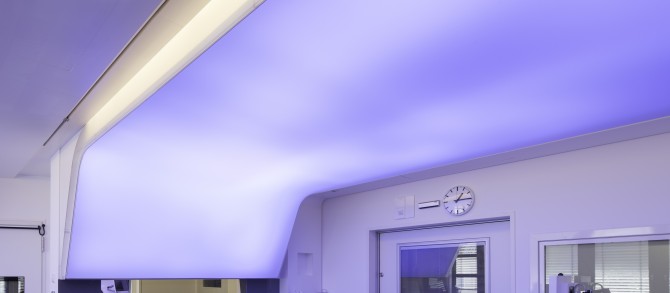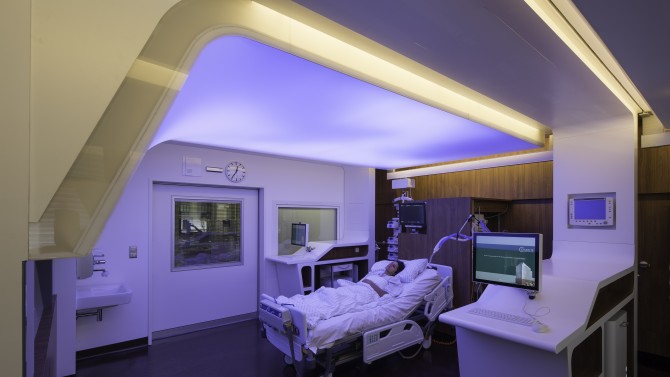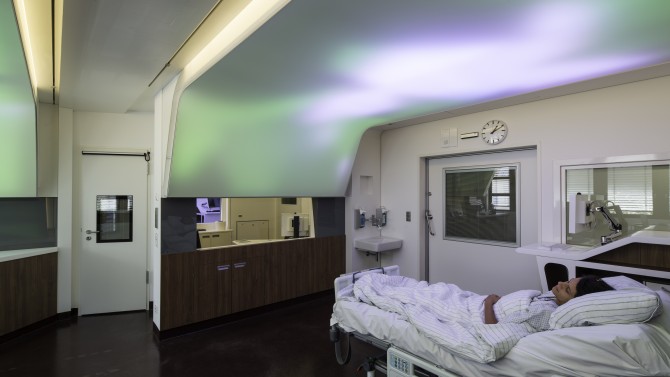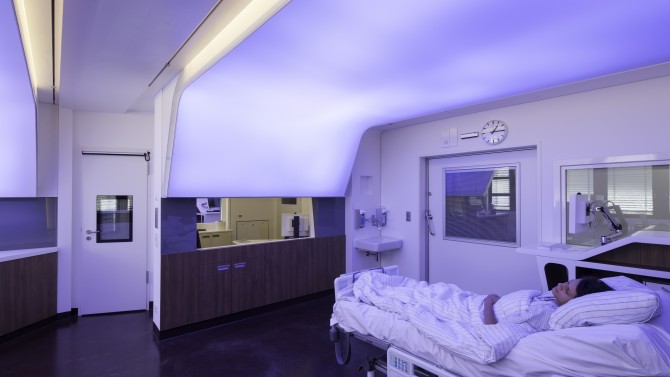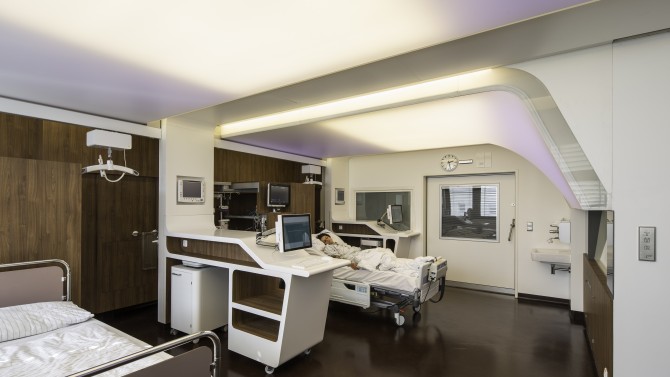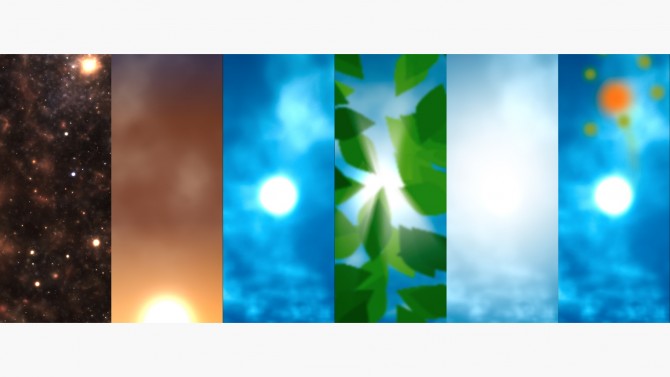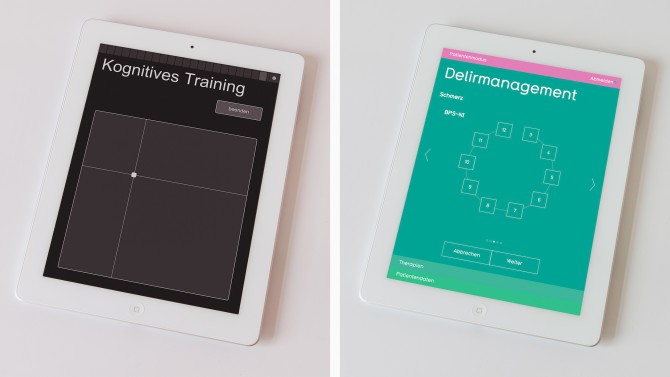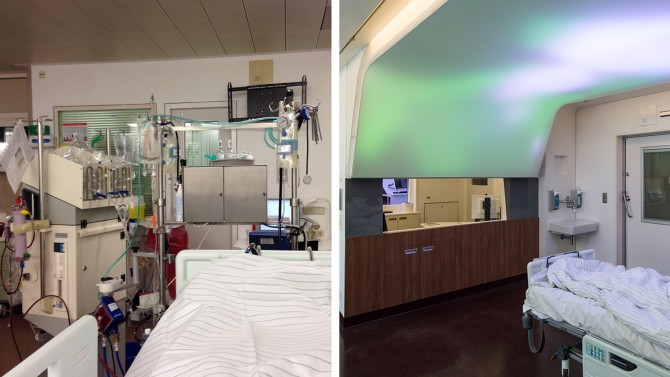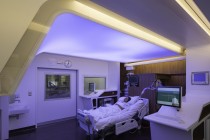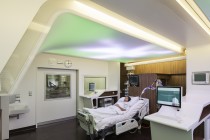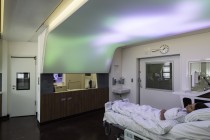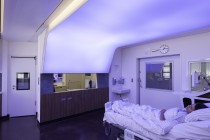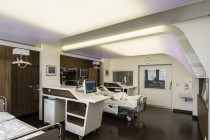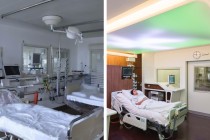Parametrische (T)Raumgestaltung, 2013
Campus Virchow-Klinikum der Charité, Berlin
Am Campus Virchow-Klinikum der Charité sind im Rahmen des Forschungsprojekts Parametrische (T)Raumgestaltung zwei neuartige Pilot-Intensivzimmer entstanden. In ihnen treten technische Geräte in den Hintergrund, während die visuelle Umgebung individuell an den Zustand der zu behandelnden Personen anpassbar wird.
Zentrale Komponente der vom Architekturbüro GRAFT gestalteten Innenraumkonzeption ist ein großformatiger, medial bespielbarer Screen, der über dem Bett angebracht ist, sich nach unten wölbt und so das Blickfeld ausfüllt. Gebaut wurde der Screen zusammen mit Philips. An die 4.000 LEDs produzieren das farbige Licht des Screens. Neben RGB-LEDs sind auch Hochleistungsleuchtdioden mit warm- und kaltweißer Lichtfarbe integriert. Sie sind in der Lage, Beleuchtungsstärken von über 20.000 Lux zu erzeugen, was in etwa der Lichteinwirkung unter freiem Himmel entspricht.
ART+COM entwickelte die medialen Bespielungen für den Screen in enger Zusammenarbeit mit der Klinik für Anästhesiologie mit Schwerpunkt operative Intensivmedizin an der Charité auf der Basis wissenschaftlicher Erkenntnisse und Theorien. Die Bespielungen sollen den Betroffenen helfen, sich zum Beispiel nach schweren Operationen oder Komas zu reorientieren. Die visuellen Inhalte lehnen sich an Naturphänomenen an und verbinden die Betroffenen mit der Außenwelt. Sie sollen kognitiv stimulierend, stressmindernd und angstlösend wirken, sodass sich die Gabe von Schmerz- und Beruhigungsmedikamenten reduzieren lässt und sich der Heilungsverlauf von intensivmedizinisch betreuten Betroffenen verbessert.
Zentraler Ansatz der Gestaltung ist die Simulation einer Tag-Nacht-Rhythmik, die den natürlichen Schlaf fördert und sich protektiv auf akute kognitive Defizite der zu behandelnden Person, sogenannte Delirien, auswirken kann. Die Farbe des Screens wechselt abhängig von der Tageszeit und simuliert so das ganze Lichtspektrum eines Tages. Wird als Parameter auch das aktuelle Wetter (am Ort oder an einem beliebigen Ort der Welt) hinzugezogen, ändert sich der simulierte Himmel entsprechend. Beispielsweise werden die Wolken dichter oder ziehen schneller vorbei. Bewegliche Objekte wie Vögel oder Kondensstreifen stimulieren die Kognition des Patienten zusätzlich.
In einer weiteren Bespielung, die angst- und schmerzreduzierend wirken soll, legen sich virtuelle Blätter eines Baumes auf den Screen. Die Farbe, Dichte, Größe und Form der Blätter kann individuell je nach Zustand der Betroffenen eingestellt werden. Werden diese Parameter wieder um Wetterdaten ergänzt, bewegt der Wind die Blätter in Relation zum aktuellem Windaufkommen. Intensivmedizinisch betreuten Betroffenen, die nachts häufig wach sind, bietet der Screen zwei verschiedene Visualisierungen: wahlweise einen ruhigen Sternenhimmel oder den Blick auf bewegliche Lichtpunkte, die an Glühwürmchen erinnern und deren Tanz die Kognition trainiert.
Der Screen zeigt veränderliche, an realen Prozessen der Natur orientierte Visualisierungen, die vom medizinischen Fachpersonal parametrisch an den Zustand der zu behandelnden Personen angepasst werden können. Dies geschieht über die Eingabe klinisch relevanter Betroffenendaten über ein spezielles Tablet-Interface.
Im gemeinsamen Forschungsprojekt Parametrische (T)Raumgestaltung kooperieren als Partner die Charité – Universitätsmedizin Berlin, das Architekturbüro GRAFT, ART+COM und die Charité CFM Facility Management GmbH. Es wird vom Bundesministerium für Wirtschaft und Technologie gefördert und erreichte 2012 den ersten Platz im Wettbewerb Design & Gesundheitswirtschaft der Berliner Landesinitiative Projekt Zukunft.
Bilder 1-8 ©Tobias Hein
